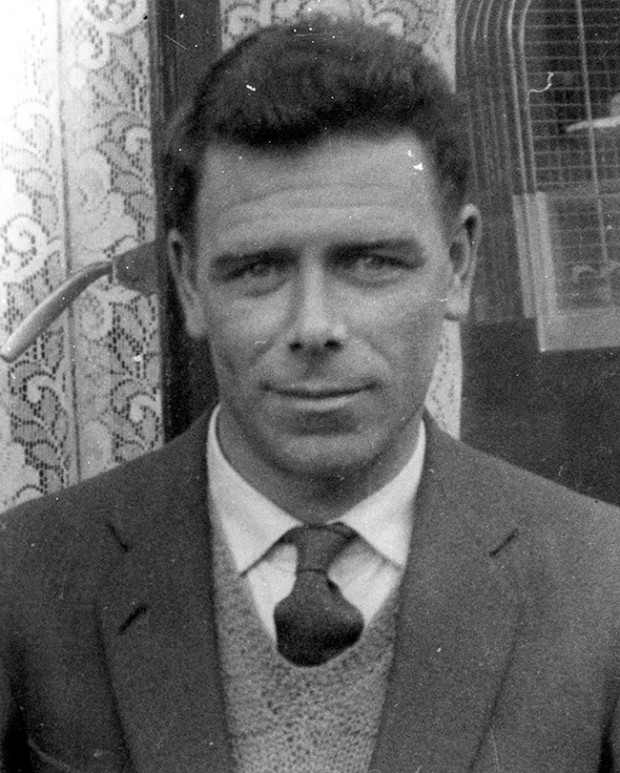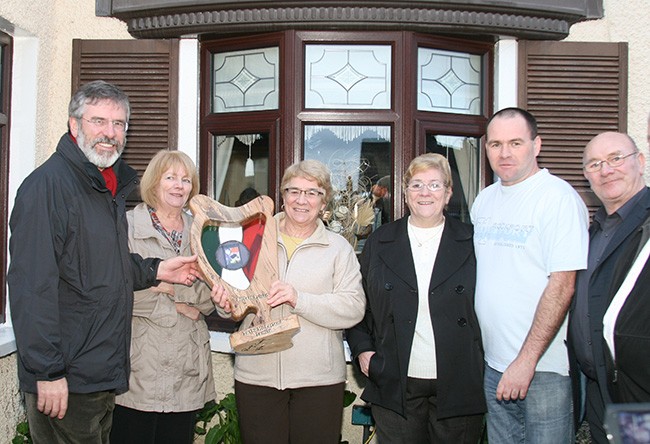5 December 2019 Edition
Remembering – Liam McParland

On October 19th 1969 I was returning to Belfast from a visit with John Joe McGirl in County Leitrim when the car I was travelling in crashed on the MI as we were approaching Belfast. I was asleep when the accident occurred. Liam McParland, who had swapped seats with me, was fatally injured and died several weeks later on 6 November.
The late Mickey O Neill was driving. Seán Wallace was the other passenger. Liam was an IRA Volunteer. He was the first to be killed in the most recent phase of the long struggle for Irish freedom. He was also the first to be buried in the County Antrim plot in Milltown Cemetery.
Liam, who was known as ‘Bulmer’ was born on 9 August 1926 in Omar Street off the Falls Road. He was the second eldest in a family of 13 and had six brothers and six sisters. He went to St. Finian’s School on the Falls Road, just beside where the Sevastopol St Sinn Féin office is.
Like most of his generation he left school at 14. Liam became an apprentice cabinet maker and eventually a well-known French polisher. The McParlands were a republican family and from an early age Liam was very involved in republican politics. He joined the Fianna, became fluent in the Irish language and enjoyed Gaelic sports, music and dance. He then joined the Irish Republican Army.
When the 1950’s IRA campaign began Liam was one of hundreds in Belfast who were arrested and interned in Crumlin Road prison. While in the Crum Liam learned to play the tin whistle and made handicrafts. He also organised Irish language classes and the occasional escape attempt.
In August 1957 an RUC Sergeant Arthur Ovens was killed in a bomb explosion near Coalisland, County Tyrone. Two 21 year old republicans Kevin Mallon and Patrick Talbot were arrested. Both were badly tortured and signed statements admitting involvement in the attack. They were remanded to Crumlin Road prison.
With the hanging of Tom Williams in 1942 still relatively fresh in their memories the Republican prisoners were afraid that the two would be hanged. So they began digging a tunnel to get Mallon and Talbot out of the prison. By the 12 March 1958 work on the tunnel was going well. It was in a cell at the bottom of an air shaft. However a prison officer discovered Liam and a comrade busily working away down the tunnel and locked the cell door to prevent them from getting out while he went to get help. Another republican prisoner realising what was happening forced the cell door open using a bar torn from the tier railings on the wing. More republicans piled into the cell, blocking the prison officers, and extracted Liam and his friend from the tunnel.
That night the RUC and prison officers wrecked the wing and many of the prisoners were savagely beaten. Visits, letters and parcels to the political prisoners were stopped. Five days later, on St. Patrick’s Day Máire Drumm – whose husband Jimmy was an internee - and several dozen wives and mothers, with prams, arrived to protest outside the main gate of the prison. When the front gate of the prison was opened to allow a prison governor to drive in to the prison the women, led by Máire, stormed the gate. The publicity, which this courageous action successfully generated, forced the prison system to resume letters, parcels and visits.

• Gerry Adams making a presentation to Liam’s family at the 40th anniversary of his death in November 2009.
On his release in 1961 from internment Liam made his way home. But by this time, while he was in the Crum, Mrs McParland had moved to Ballymurphy so the story is often told by his surviving siblings of how Liam walked slowly up Ballymurphy Road rapping on doors asking if the McParlands lived there.
I met Liam in 1968 or early ‘69. Ballymurphy was my home district. I was reorganising Sinn Féin. After the pogroms there was a large influx of members. There was also a flood of refugees into the ‘Murph. There was a huge communal effort to take care of them alongside the defence of the district.
My abiding memory of Liam is of a quiet thoughtful man, a Gaeilgeoir, a committed republican. Someone who enjoyed a bit of craic. Seamus Drumm remembers him as a close personal family friend to his mother Máire and father Jimmy. The McParlands and the Drumms often socialised together in the Casement Park social club and Liam, who enjoyed fishing, would take a young Seamus on fishing adventures to Glenavy.
Liam was also a close friend to Proinsias Mac Airt one of the leading Belfast republican leaders of his generation. Proinsias was a committed Gaeilgeoir and a fine seán nos singer with a great range of traditional songs in Irish and English.
The two, both bachelors, would often be found together in Kelly’s Cellars in Belfast discussing with other republicans the dramatic events and changes that were taking place in the North and within republicanism in the late 1960’s. The 1969 pogroms when the RUC and unionist mobs burned out hundreds of Catholic families in Belfast was a turning point.
Joe Cahill, in his book, ‘A Life in the IRA’ recalled the chaos of August 1969. He met Liam in the Divis Street area. He said: “Liam McParland had been appointed by the IRA to look after the area that night. I met him in Divis Street. He had been interned with me in the 1950s. I asked him what was happening and he said, ‘I don’t know, but this is what I have been given,’ and showed me an anti-personnel grenade. He said that shortly after it was given to him, he discovered it was unarmed and contained no explosive, no fuse, nothing. I can remember the anger in that man’s eyes and in his voice. He had been searching for a member of Belfast Battalion staff – any member. He said: ‘I can’t find these people, I don’t know where they have gone.’”
In the months that followed, this anger and frustration at the then leadership of the IRA led in December to the split between what came to be for time called the ‘Officials’ and the ‘Provisionals’.
When Liam McParland died on 6 November 1969 hundreds attended his wake. Men and woman from the 1940s and 50’s and 60’s crowded into his home to offer their sympathies to Mrs McParland and to regale her with stories of her son’s time in prison. A few weeks after his funeral comrades went to his graveside in Milltown Cemetry and fired three volleys in honour of a brave and faithful republican.
Liam died fifty years ago. Go ndeanfaidh Dia trocaire air.




